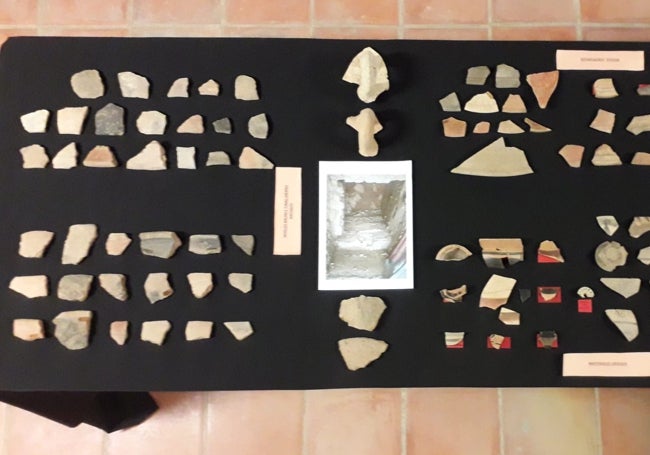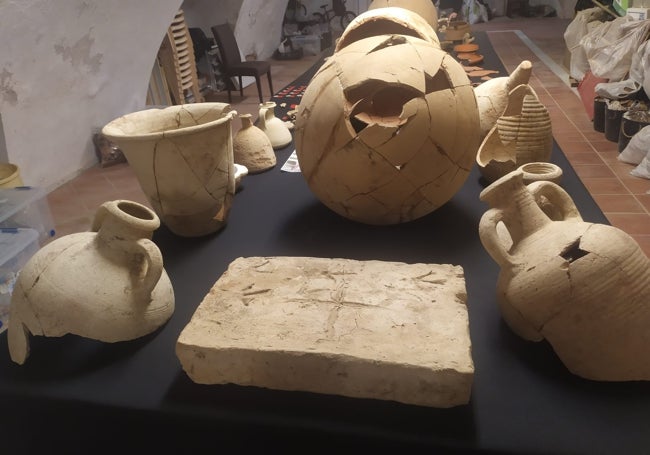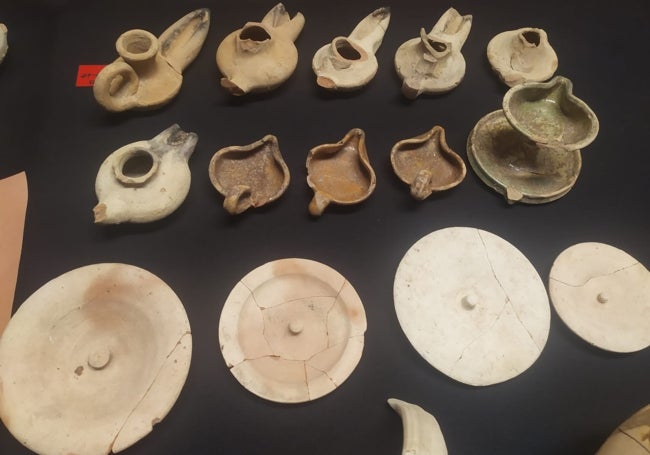Malaga city just got 1,000 years older as new remains are uncovered near cathedral
Excavation carried out in Calle Postigo de Abades to install the crane in readiness for work on the new roof reveals pieces that now date the history of the city back to the Copper Age, not the Late Bronze Age
Rather than digging a lot, the key is to dig in the right place. A maxim that archaeologists know only too well. One of these experts keeps repeating this phrase thanks to recent events. The archaeologist in question is Juan de Dios Ramírez, who has been in charge of excavations at Malaga cathedral for almost a decade and who has come across a startling revelation concerning the history of Malaga. In an excavation of just seven square metres in Calle Postigo de Abades to install the crane for work on the roof of Malaga's main church they have come across the oldest remains ever to be found in the city. They date from 5,000 years ago, putting the city's occupation back by a thousand years to the Chalcolithic or Copper Age (after Neolithic and before the Bronze Age).

"Until now the oldest remains of the city dated from the Late Bronze Age and were found far from the centre, in the district of Trinidad in the so-called settlement of San Pablo, while what we have found at the base of the cathedral is much older, since it is from the beginning of the third millennium BC and we are talking about an important leap back in time for the origins of the occupation of Malaga," explained Ramírez without hiding his "excitement" that this news has changed the history of Malaga. It is most certainly a transcendental piece of information that will force us to rewrite our past, but it does not stop there.

The small excavation to provide a new roof for the cathedral has been overshadowed by this rewriting of the history of Malaga. This most recent, accidental achaeological finding has also allowed us to take readings of how the city has evolved from prehistoric to later Phoenician, Roman, Byzantine and medieval occupation with the discovery of these earlier remains. More than ever, it can be said that this was the old quarter of Malaga. In fact, the oldest.

This great historical journey was made possible by the fact that the excavations were able to go down four and a half metres, which made it possible to obtain a stratigraphy (the study of strata, or layers, of rock formed by volcanic activity) from the Chalcolithic period to the present day.
From top to bottom, the remains of an Islamic house and pottery from the Almohad period gave way to earlier traces with remains of Byzantine warehouses and Roman construction, mainly fish salting tanks such as those found throughout this area from Calle Alcazabilla and the Roman Theatre, although floor tiles with carved inscriptions have also been found and are currently being studied.
"During the Roman period in Malaga the whole city became a fish factory in the Lower Imperial period, so in order to build the basins, they used a strong foundation that destroyed what was underneath. The good thing about this excavation is that a couple of adjoining rooms without basins were found, which allowed us to drill down to find Punic, Phoenician and, finally, Chalcolithic remains," explained Juan de Dios Ramírez.
From monumental to informative
Continuing with this timeline, the Phoenician remains also provide relevant data on the city, with an abundance of Greek pottery that confirms Malaga as a centre of trade within the Mediterranean from the 6th century BC, to which are added the more monumental remains of wall-hangings of up to two metres that date back to the 7th century BC, the date at which the roots of this Eastern civilisation are found in the city.

On the next level, at a depth of four and a half metres and thanks to the fact that this area was not ruined by the Roman fish basins, the most revealing remains of this dig near the cathedral were found: original pieces from the Chalcolithic period that had never been documented until now in Malaga city. Previous studies place the city's origin at the beginning of the third millennium BC (5,000 years ago), whose archaeology revealed hand-made ceramics, burnished bowls, plates, dishes, bowls, half-glazed storage pots and other kitchen items.
According to the cathedral's archaeologist, Juan de Dios Ramírez, the Copper Age people were known for being on the move, although this discovery indicates "a small settlement on what was then the promontory of the cathedral, which faced the sea and was an interesting site from a maritime and fishing point of view as an area for capturing resources, a well-laid-out space that was later also occupied by the Phoenicians due to its strategic location."

"From now on we will have to refer to 5,000 years ago to talk about the first occupation of Malaga," said Ramírez. Nevertheless, he hopes that this great little taster of the city's 'new' history will yield yet more data and discoveries: "We still have a lot of hard work ahead of us to investigate all these finds."
You only have to enter the room in the cathedral that houses the remains and look at the tables filled with hundreds of pieces from different periods - some already assembled as they are complete - to get an idea of the secrets yet to be revealed of this legacy left by our most ancient ancestors.

